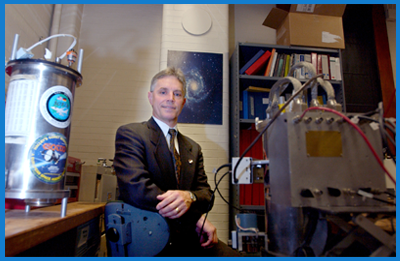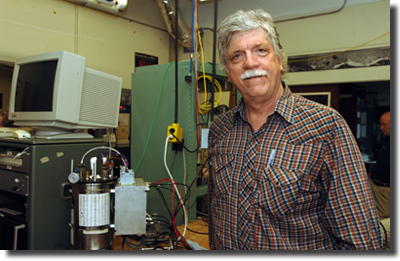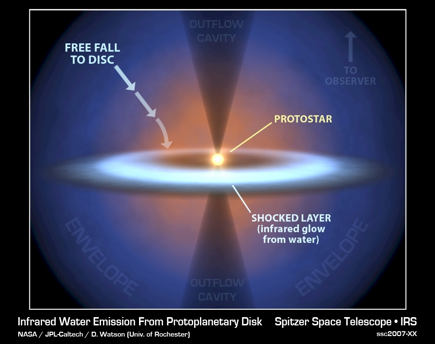Embryonic Solar System Assembly Seen for the First Time
 Using NASA's Spitzer Space Telescope, a team of astronomers led by Professor Dan M. Watson of the University of Rochester has observed the onset of planetary-system formation, a process nobody has seen until now. The group's exciting first look at the creation of an embryonic solar system yields many new insights about the physics and chemistry of evolving astronomical objects.
Using NASA's Spitzer Space Telescope, a team of astronomers led by Professor Dan M. Watson of the University of Rochester has observed the onset of planetary-system formation, a process nobody has seen until now. The group's exciting first look at the creation of an embryonic solar system yields many new insights about the physics and chemistry of evolving astronomical objects.
Publishing their results in the August 30, 2007 issue of Nature, the researchers note that the Spitzer Space Telescope enabled them to see water, in the form of ice, "raining" from a cloud enveloping the infant star NGC 1333-IRAS 4B approximately 1,000 light years away from Earth. The ice is vaporizing as it lands supersonically on a dense, dusty disk surrounding the baby star, a long-sought phenomenon called a disk-accretion shock. In time, planets will form within the dusty disk.
"What's special about the Spitzer Space Telescope," says Professor Watson, "is that it lets us see through dense dust and gas clouds. In fact, we're now able to see what used to be invisible material at the cores of protostellar condensations." Of the 30 protostars -- embryonic solar systems -- studied by Watson's team, only NGC 1333-IRAS 4B displayed what was going on during the formation of what someday will be planets.
 Using infrared light emitted by the water vapor, the scientists calculate the current "rainfall rate" to be about 23 Earth masses per year, and the water present in the shock-heated surface of the disk could fill Earth's oceans about five times. They also report that the disk's radius exceeds the distance between Earth and Pluto, and that its temperature is 170 Kelvin, or -154 degrees Fahrenheit.
Using infrared light emitted by the water vapor, the scientists calculate the current "rainfall rate" to be about 23 Earth masses per year, and the water present in the shock-heated surface of the disk could fill Earth's oceans about five times. They also report that the disk's radius exceeds the distance between Earth and Pluto, and that its temperature is 170 Kelvin, or -154 degrees Fahrenheit.
Why is there a disk of gas and dust around the embryonic star? Galaxies like ours have a lot of material in the form of gas and dust between the stars. This interstellar medium exists as a wide variety of clouds, including dense molecular clouds where the stars and planetary systems form. Fragments of material coalesce into clumps, cool, and can collapse very quickly under their own weight. These fragments spin faster as the collapse proceeds due to the conservation of angular momentum. Centrifugal force impedes the collapse in two directions, and the cloud collapses fastest in the direction of the axis of rotation. This process flattens the cloud, so the result of collapse and spin is to create disk-shaped assemblies of matter.
Thus, the collapsing cloud fragment becomes a slightly flattened spheroid shape called the envelope. Inside the envelope is a dense disk called the protoplanetary disk, which eventually turns into a system of planets. At the center of the disk is the protostar, a rounder shape that evolves into an actual star.
The protostar gathers mass as the envelope rains down on the protoplanetary disk, and matter from the disk falls onto the protostar. During the first 10,000 years after the initial formation of the embryonic solar system structures, the protostar ends up accreting most of its eventual mass.
So what does the future hold for the embryonic NGC 1333-IRAS 4B system?
 University of Rochester Professor William J. Forrest, a key collaborator on the Spitzer project, supplies some clues. "NGC 1333-IRAS 4B is in good shape for making a system of planets within the disk. This observation strongly supports a fundamental premise of star formation: stars can't form directly, but rather, first form a disk surrounding the nascent star. It is from disks that planets can form."
University of Rochester Professor William J. Forrest, a key collaborator on the Spitzer project, supplies some clues. "NGC 1333-IRAS 4B is in good shape for making a system of planets within the disk. This observation strongly supports a fundamental premise of star formation: stars can't form directly, but rather, first form a disk surrounding the nascent star. It is from disks that planets can form."
Professors Forrest and Watson were both on the team that built the Spitzer Space Telescope and its Infrared Spectrograph from 1983 to 2003. They've been studying these embryonic systems for a long time. They point to one other significant aspect of embryonic solar system assembly that they have now observed:
A protostar has an extremely slow spin rate. If a protostar were to retain all of the material that rains down upon it, the protostar would never settle down. Instead, it would break apart. The pressure and magnetism in a protostar keep this from happening by ejecting much of the material that is trying to fall onto the protostar. The material is ejected out the poles of the protostar, carrying with it most of its spin. Hence, the material that does accrete to the protostar has little spin to it and is able to settle down onto the protostar. As long as the envelope is moving material onto the disk, this ejection, or outflow, of material continues.
NGC 1333 IRAS 4B is known to have such an outflow. It is through the tunnel carved by this outflow, shaped somewhat like a cone, that the NASA Spitzer team is able to view the core of the developing solar system.

Authors of the Nature paper include Professors Dan Watson and William J. Forrest of the University of Rochester Department of Physics and Astronomy; Chris Bohac and Chat Hull, both former undergraduate students of Dan Watson; and Jim Houck of Cornell University, who heads the Spitzer Infrared Spectograph team. (lhg)
Additional Details
For further details, see:
Dan M. Watson, C. J. Bohac, C. Hull, William J. Forrest, E. Furlan, J. Najita, Nuria Calvet, Paola d'Alessio, Lee Hartmann, B. Sargent, Joel D. Green, Kyoung Hee Kim, and J. R. Houck, "The development of a protoplanetary disk from its natal envelope," Nature, August 30, 2007.
Nature: http://www.nature.com/index.html
Podcast featuring Professor Dan Watson:http://www.nature.com/nature/podcast/index.html
NASA/JPL official press release: http://www.spitzer.caltech.edu/Media/releases/ssc2007-14/
Science: http://sciencenow.sciencemag.org/cgi/content/full/2008/313/2
